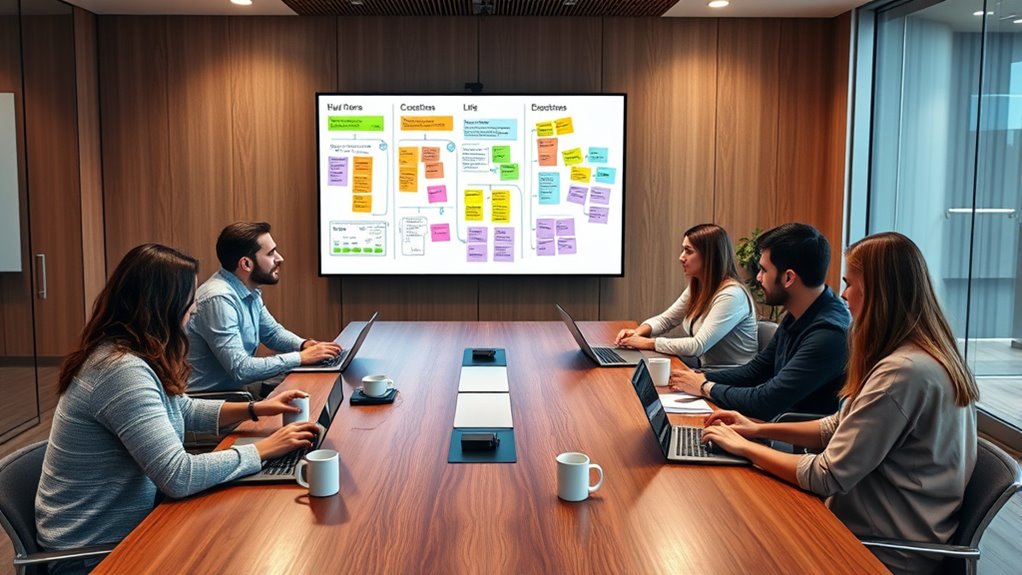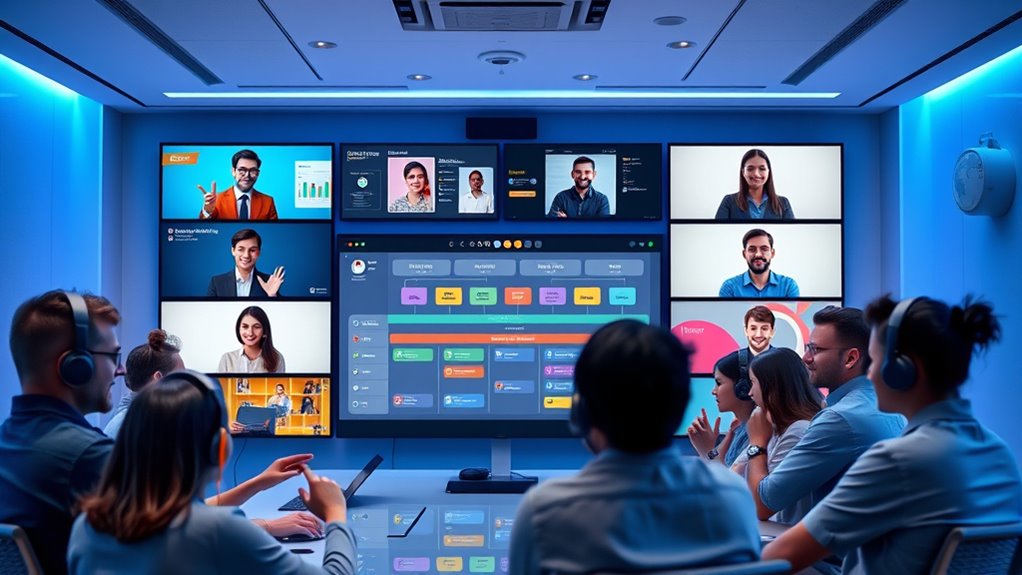To design effective focus sprints for distributed teams, you should understand their unique dynamics, including cultural differences and time zone challenges. Set clear, measurable goals and define responsibilities well to keep everyone aligned. Choose collaboration tools that support real-time and asynchronous communication. Schedule meetings thoughtfully to accommodate everyone’s schedules and foster engagement through regular check-ins and recognition. Want to learn how to implement these strategies smoothly? Keep exploring for practical tips to optimize your sprints.
Key Takeaways
- Establish clear, measurable goals and responsibilities tailored to remote team dynamics to ensure alignment and accountability.
- Schedule meetings across time zones with rotation and advance notice to maximize participation and inclusivity.
- Utilize collaboration tools that support real-time, asynchronous communication and visual sharing to maintain momentum.
- Incorporate regular feedback and performance metrics to monitor progress and inform iterative improvements.
- Foster team engagement through virtual bonding, recognition, and open communication to sustain motivation and cohesion.
Understanding the Unique Dynamics of Remote Teams

Remote teams operate in a fundamentally different environment than co-located groups, which means their dynamics require careful understanding. You need to recognize that cultural nuances heavily influence communication, collaboration, and trust-building. Different backgrounds can lead to varied expectations and working styles, so being aware of these differences helps avoid misunderstandings. Leadership styles also play a pivotal role; some leaders adopt a more hands-on approach, while others empower team members to work independently. Adapting your leadership to accommodate diverse cultural norms and individual preferences fosters engagement and accountability. By understanding these unique aspects, you can create an environment where remote team members feel valued, understood, and motivated to contribute effectively. Incorporating team dynamics insights can further enhance your approach to managing distributed teams. This foundation is key to designing successful virtual focus sprints.
Setting Clear Goals and Expectations for Virtual Sprints

You need to set clear goals for your virtual sprints to keep everyone aligned. Make sure each team member understands their responsibilities and what’s expected of them. When goals are specific and responsibilities are defined, your team can work more efficiently and stay focused. Incorporating ethical hacking principles can help identify potential vulnerabilities early, ensuring your goals include proactive security measures.
Defining Sprint Objectives Clearly
Clear sprint objectives are essential for guiding distributed teams and ensuring everyone stays aligned throughout the virtual sprint. When your goals are specific and well-defined, you promote clarity of objectives, which minimizes confusion and keeps the team focused. Communicate these goals clearly to foster stakeholder alignment, so everyone understands what success looks like. Use the following table to help set and visualize your sprint objectives:
| Objective Aspect | Description |
|---|---|
| Specificity | Define exact deliverables or outcomes |
| Measurability | Set criteria to track progress |
| Relevance | Ensure goals align with project goals |
| Time-bound | Attach deadlines for completion |
| Stakeholder Alignment | Confirm objectives meet stakeholder expectations |
Additionally, understanding how contrast ratio influences image quality can help teams set clearer visual goals for project presentations or collaborative workspaces.
Establishing Team Responsibilities
Establishing team responsibilities is crucial for setting clear goals and expectations in virtual sprints. When you define roles clearly, everyone understands their specific contributions, which enhances role clarity. Responsibility assignment ensures each team member knows what they’re accountable for, reducing confusion and overlaps. To achieve this, clarify who handles each task from the start, and communicate these responsibilities openly. This proactive approach supports role clarity and prevents misunderstandings, keeping the sprint focused. Regular check-ins can help confirm responsibilities are clear and adjustments are made promptly. By establishing responsibilities upfront, you foster accountability and streamline collaboration. Clear role clarity and responsibility assignment are key to aligning your team’s efforts toward shared goals and ensuring a productive, focused virtual sprint.
Choosing the Right Tools for Collaboration and Communication

Selecting the right communication platforms keeps everyone connected and on the same page. You also want collaborative workflow tools that streamline task management and boost productivity. When chosen carefully, these tools can make your virtual sprints more efficient and focused. Incorporating wall organization systems can further enhance visual interest and functionality during team collaborations.
Seamless Communication Platforms
How do you guarantee your distributed team stays connected and productive? The key is choosing seamless communication platforms that facilitate real-time interaction. These tools should support virtual brainstorming sessions, allowing team members to share ideas instantly. Digital whiteboards are essential for visual collaboration, helping everyone contribute ideas clearly and efficiently. Look for platforms that integrate chat, video calls, and file sharing to keep communication fluid. Consistent, easy-to-use tools prevent misunderstandings and keep everyone aligned. When your team can switch effortlessly between different modes of communication, productivity increases, and focus sprints become more effective. Ultimately, the right combination of communication platforms creates a cohesive environment where collaboration flows naturally, no matter where team members are located. Additionally, understanding the divorce statistics can help teams recognize the importance of clear communication to manage conflicts and maintain stability in their work relationships.
Collaborative Workflow Tools
Choosing the right collaborative workflow tools directly impacts your team’s ability to stay aligned and productive across distances. Look for platforms that support asynchronous feedback, allowing team members to contribute ideas and review work on their schedules, which helps maintain momentum. Virtual brainstorming features enable your team to generate and organize ideas collectively, even when working asynchronously. These tools should facilitate clear communication, streamline document sharing, and integrate seamlessly with your existing systems. Prioritize user-friendly interfaces to reduce onboarding time and promote consistent engagement. Incorporating visual collaboration features can further enhance idea development and team interaction, making your workflow more dynamic. With the right tools, your team can overcome geographical barriers, encourage creative collaboration, and keep focus sprints on track. Ultimately, selecting effective collaboration platforms enhances transparency, accountability, and efficiency within your distributed team.
Scheduling and Time Zone Considerations

When planning focus sprints for distributed teams, considering different time zones is essential to guarantee everyone can participate effectively. To achieve this, prioritize time zone synchronization by scheduling sessions at times that minimize inconvenience for all members. Use flexible scheduling to accommodate varying work hours and personal commitments, ensuring team members aren’t forced into early mornings or late nights. Communicate the sprint schedule well in advance, allowing team members to plan accordingly. Consider rotating meeting times if your team spans multiple regions, so no one bears the brunt of inconvenient hours consistently. Additionally, understanding regional work habits and cultural differences can enhance team cohesion and participation. By thoughtfully managing scheduling and time zone differences, you create an inclusive environment that maximizes participation, fosters engagement, and keeps your distributed team aligned and productive throughout the focus sprint.
Fostering Engagement and Accountability in Distributed Environments

Building engagement and accountability in distributed teams requires intentional strategies that foster connection and responsibility. You can achieve this through virtual team bonding activities that create a sense of camaraderie, even when apart. Regular asynchronous check-ins allow team members to share updates, ask questions, and stay aligned without the need for real-time meetings. These check-ins encourage accountability by making individual progress visible and providing opportunities for feedback. To keep everyone engaged, set clear expectations and encourage open communication. Recognizing contributions publicly to motivate participation and strengthen team cohesion is also effective. When team members feel connected and responsible for their tasks, productivity increases, and the team functions more smoothly. Incorporating effective communication strategies helps ensure everyone stays informed and engaged. Prioritizing these practices helps build a resilient, accountable distributed team culture.
Measuring Success and Iterating for Continuous Improvement

To guarantee your focus sprints deliver meaningful results, you need to measure progress accurately and use that data to drive improvements. Performance metrics help you track tangible outcomes, while feedback loops ensure continuous learning. Focus on these key areas: 1. Define clear performance metrics aligned with sprint goals to gauge success effectively. 2. Regularly collect feedback from team members through surveys or quick check-ins to identify obstacles and opportunities. 3. Use insights from metrics and feedback to iterate processes, adjusting tactics to enhance productivity and outcomes. Additionally, understanding Gold IRA regulations can help ensure compliance and optimize investment strategies during your planning process.
Frequently Asked Questions
How Can I Adapt Focus Sprints for Highly Cross-Functional Remote Teams?
You can adapt focus sprints for highly cross-functional remote teams by leveraging virtual collaboration tools to facilitate seamless communication. Guarantee stakeholder engagement by setting clear goals and involving all team members early in planning. Use regular check-ins and shared digital workspaces to keep everyone aligned. These strategies help maintain focus, foster collaboration, and drive progress, even when team members are geographically dispersed.
What Are Effective Ways to Handle Conflicts During Virtual Sprint Sessions?
When handling conflicts during virtual sprint sessions, you should prioritize conflict resolution by encouraging open communication and active listening. Use emotional intelligence to recognize team members’ feelings and address issues empathetically. Foster a safe environment where everyone feels heard, and steer discussions toward collaborative solutions. By staying calm and demonstrating understanding, you can resolve conflicts effectively, ensuring the team remains focused and productive throughout the sprint.
How Can Managers Maintain Team Morale in Long-Distance Focus Sprints?
You understand that maintaining team morale during long-distance focus sprints can be challenging yet rewarding. By prioritizing virtual team building, you foster connection and trust, boosting morale even from afar. Incorporate fun activities, celebrate achievements, and keep communication transparent. These morale-boosting strategies create a positive environment, ensuring your team stays motivated and engaged throughout the sprint, despite physical distance.
What Are Best Practices for Onboarding New Team Members Into Ongoing Sprints?
When onboarding new team members into ongoing sprints, you should use onboarding checklists to guarantee they understand project goals and tools. Pair them with a mentor for guidance and quick integration. Communicate clearly about sprint expectations, set up regular check-ins, and encourage questions. This approach helps new members contribute effectively, feel welcomed, and stay aligned with team objectives, even in a distributed environment.
How Do I Balance Asynchronous and Synchronous Activities During Distributed Sprints?
Oh, the irony of balancing asynchronous and synchronous activities—surely you’d think it’s simple, right? In reality, you juggle different time zones and choose the right communication channels so everyone stays aligned. You schedule key meetings thoughtfully and encourage flexible updates. By doing this, your team stays productive without feeling overwhelmed, even when working across continents. It’s all about smart timing and clear communication—simple in theory, tricky in practice!
Conclusion
By embracing the unique rhythms of your remote team, you set the stage for focused success. Clear goals, the right tools, and thoughtful scheduling act like the gears of a well-oiled machine, driving your sprints forward. Stay engaged, hold each other accountable, and continually refine your approach. When you nurture these elements, your distributed team can soar together, turning challenges into stepping stones on the path to winning sprint after sprint.









